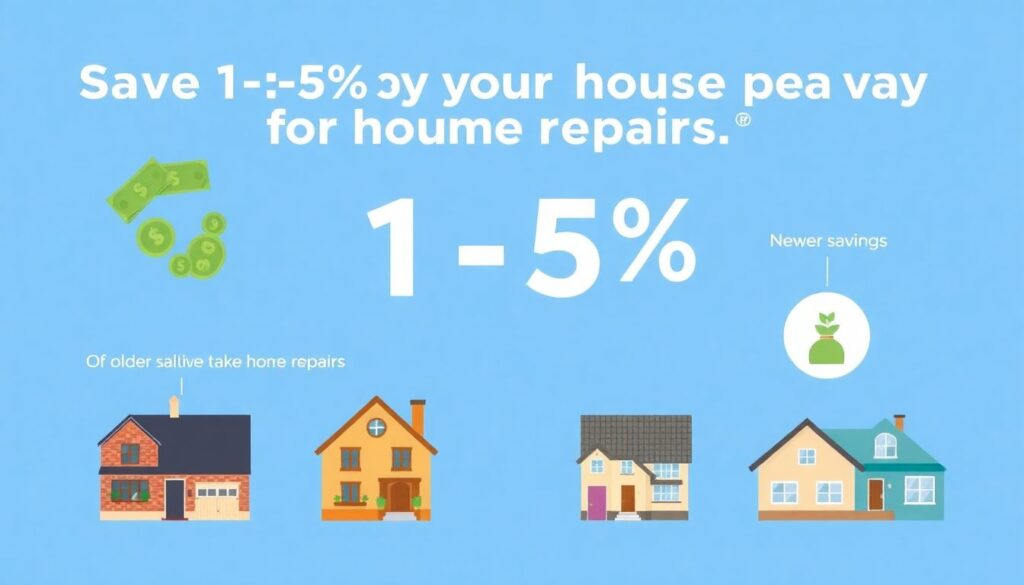Why a Home Maintenance Fund Is Non‑Negotiable
Picture this: the water heater dies on a freezing Sunday night, and instead of panicking, you open your banking app, tap the “House Care” savings, and calmly call the plumber. That feeling isn’t luck; it’s systems plus discipline. A home maintenance fund is essentially self‑insurance against slow, silent damage and loud, expensive failures. Experts in housing economics argue that regular maintenance can add decades to a building’s life and drastically smooth out your cash flow. Seen this way, you’re not “throwing money into a pit”, you’re buying stability, preserving asset value, and protecting your future self from being forced into bad, rushed financial decisions every time something breaks.
If you’ve ever felt blindsided by a repair bill, the goal of this guide is simple: turn “why is this happening to me?” into “I saw this coming; I’m ready.”
home maintenance fund: how much to save without overdoing it
Let’s tackle the big anxiety first: the classic question, “home maintenance fund how much to save each month?” Most building scientists and financial planners converge on a few practical rules. The traditional 1% rule says you should expect to spend about 1% of your home’s value per year on upkeep; some pros bump that to 1–3% for older or complex homes. Another approach is to think in terms of systems and timelines: roofs every 20–30 years, boilers every 10–15, exterior paint every 7–10, and so on. When you add those schedules up, you realize maintenance isn’t random chaos; it’s a predictable pipeline of future costs that you can reverse‑engineer into a monthly savings number, instead of being shocked every few years.
A simpler way, if you hate math: aim for one full month of living expenses in home maintenance savings as a starter goal, then grow from there.
Percentages that actually work in real life

Money pros often prefer a percentage‑based approach because it automatically scales with your income. A common expert guideline is to set a fixed percentage of income to save for house repairs, typically 1–5% of your take‑home pay, depending on the age and condition of your property. Younger homes in mild climates can often sit closer to the lower end; older homes, or those with complicated roofs, basements, or severe winters, belong on the higher end. The key point: this percentage isn’t “extra” money; it’s part of the true cost of owning. If your budget only works when maintenance is zero, the numbers aren’t honest, and you’ll pay for that illusion later, with interest.
How to budget for home repairs and maintenance without feeling deprived
When you hear “how to budget for home repairs and maintenance,” it’s easy to imagine some rigid spreadsheet and a joyless life without coffee or vacations. That’s not the goal. Think in terms of containers: one for fixed bills, one for flexible fun, one for long‑term goals, and one for the house. Expert financial coaches suggest naming that house container explicitly in your banking app—“Home Safety Net” beats “Savings 2” by a mile for motivation. Then you automate transfers right after payday, treating this fund like a non‑negotiable bill. Psychologically, this shifts maintenance from a surprise intruder to a regular, expected guest. Instead of asking “can I afford this repair?”, you ask, “how do I best use the money I already set aside for this exact situation?”
You don’t need complex software at first; a simple second savings account and a recurring transfer will outperform a perfect plan you never implement.
The best way to save money for home maintenance in practice
Experts who work with homeowners long‑term tend to recommend a layered approach as the best way to save money for home maintenance. First layer: cash in a high‑yield savings account dedicated solely to the house—quick access for plumbers, roofers, and emergency electricians. Second layer: a long‑term sinking fund for big‑ticket items like roof replacements; this can also sit in safe, liquid instruments, but you’re thinking in 5–10‑year horizons, not 5–10 days. Third layer: knowledge. Every hour you invest in understanding basic building science, reading inspection reports properly, and learning seasonal maintenance tasks can literally save thousands. Maintenance isn’t only about money stored; it’s also about failures avoided because you caught a tiny issue before it turned into structural damage.
Tools, calculators, and expert tricks

If numbers stress you out, use them as a crutch rather than a burden. A home repair emergency fund calculator can turn vague anxiety into a concrete monthly target. Plug in your home’s age, size, and value, and you’ll get a rough savings goal that you can adjust with local knowledge—climate, construction type, and how well previous owners cared for the place. Housing advisors emphasize: don’t obsess over precision; the error isn’t in saving 20% too much, it’s in saving nothing. Once you have a ballpark figure, lock it in as an automatic transfer and then revisit once a year. Think of it as an annual check‑up for your finances that mirrors the annual check‑up an inspector would do for your property.
Point is, you outsource the complex calculations to tools, but you stay in charge of decisions and priorities.
Real‑world cases: from constant crises to quiet confidence

Consider Anna, who bought a 30‑year‑old home and spent her first two years in what she calls “repair roulette”—every few months, something expensive broke. After tracking a full year of issues, she realized the pattern: they weren’t random; the house was just hitting the age where many original components fail. She set up a dedicated account, committed 4% of her net income to it, and used a simple spreadsheet to list each system, its age, and replacement cost. Five years later, she’s replaced the water heater, updated electrical panels, and partially redone the roof—all paid in cash from her fund. Another example: a couple who started small, just $50 per month, and added every raise or bonus to their home account. Ten years on, their maintenance fund covered a full HVAC replacement without touching credit. These stories aren’t miracles; they’re the result of boring, repeatable habits that anyone can copy.
They didn’t need higher income so much as clearer structure and the discipline to stick with a plan long after the initial motivation faded.
How to develop your “homeowner skillset” and where to learn
Money is only half of a solid maintenance strategy; the other half is competence. Even if you never plan to swing a hammer, knowing the basics helps you prioritize repairs, avoid being upsold, and decide when “good enough” is actually good enough. Development here means gradually building a mental model of your home: where shut‑off valves live, how water drains, what “normal” noises your boiler makes. Building‑science educators suggest a simple routine: one hour per month of learning (books, YouTube channels run by licensed pros, local workshops at hardware stores) and one short walkthrough of your property with a notebook in hand. Over time, you’ll catch small leaks, hairline cracks, or ventilation issues long before they turn into insurance claims, and your maintenance fund will stretch much further.
Reliable resources include government housing guides, reputable DIY channels that emphasize safety, and local classes on basic home systems—not random hacks that ignore building codes.
Staying motivated when there’s always something “more fun” to do
Saving for a home maintenance fund is rarely exciting in the moment; no one posts selfies with their new expansion tank. Motivation comes from connecting that quiet fund to loud life goals: less debt, more freedom to change jobs, the ability to host family without worrying about what might fail. One expert trick is to give your fund a name that reflects the outcome, not the chore—“Future Freedom House”, not “Maintenance”. Another is to tie regular check‑ins to positive rituals: once a quarter, review your home fund over a good coffee, update your list of upcoming repairs, and choose one small, visible improvement (like fresh caulk or a tune‑up) that reminds you why you’re doing this. You’re not just preventing bad things; you’re steadily building a safe, resilient space that supports the rest of your life.
In the long run, that boring little automatic transfer is what turns a house from a financial wild card into a stable, predictable asset you can actually enjoy.

